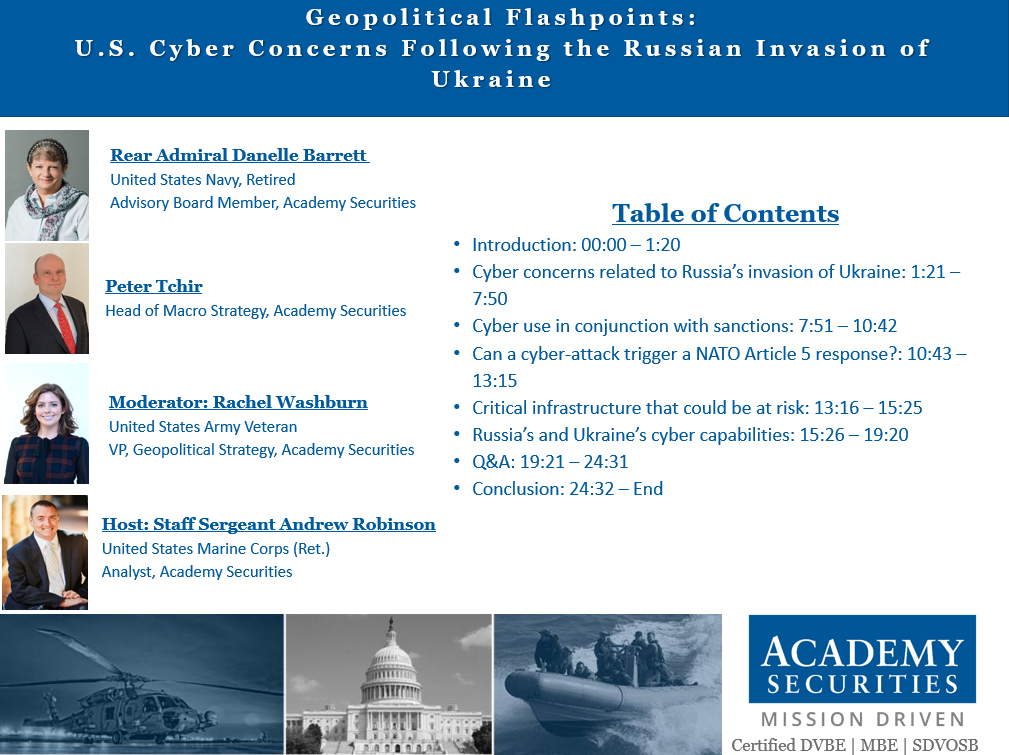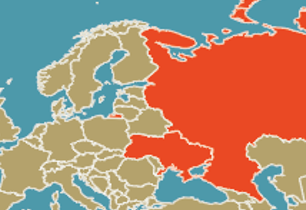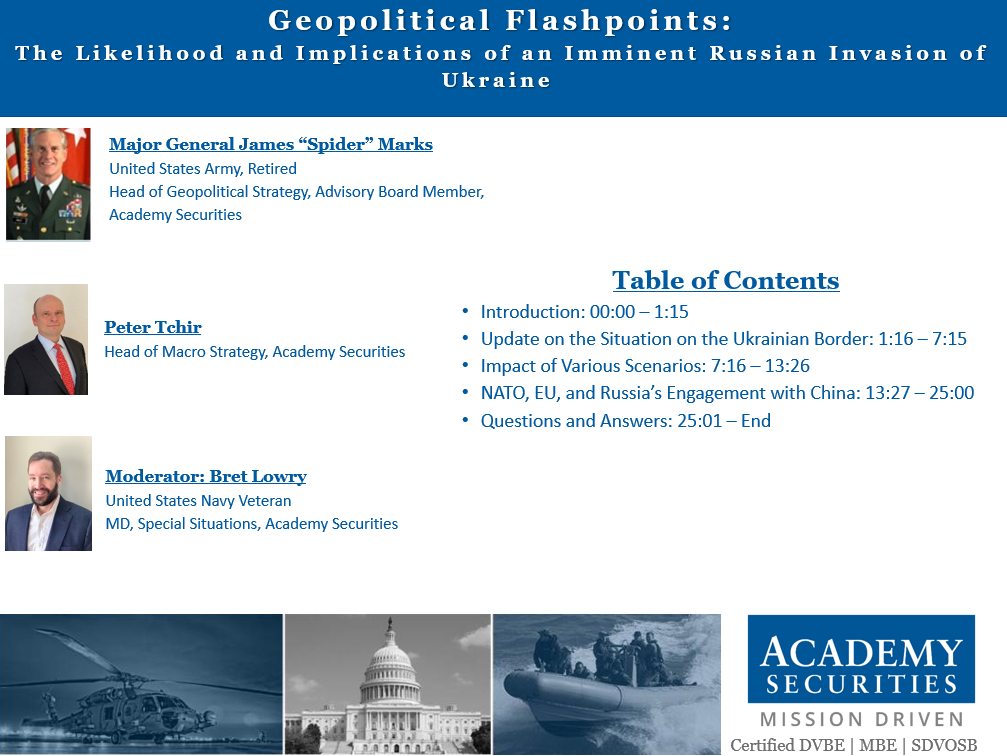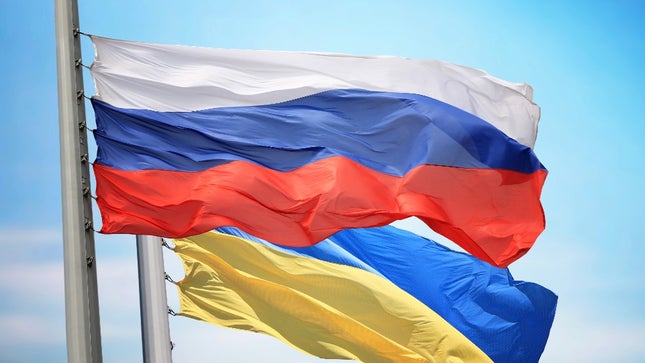Month: February 2022
A Full-Scale Invasion of Ukraine
- On February 21, Putin announced that Moscow would recognize the Donetsk and Luhansk People’s Republics in eastern Ukraine and sent Russian “peacekeeping troops” into the region.
- Initially, the U.S. announced sanctions on only the breakaway regions, but on February 22, a Russian focused “first tranche” set of sanctions was announced targeting two sizable Russian financial institutions, Russian sovereign debt, and Russian elites (and their families).
- The UK, Japan, and Australia announced that they would levy sanctions against Russia, and Germany announced that it will not grant the final approvals for the Nord Stream 2 pipeline.
- Last night, Putin announced that Russia has commenced a “special military operation” in Ukraine – effectively a full-scale invasion on multiple fronts.
- Putin said that the intent of the operation was to protect Russians living in the Donbas and that Russia did not intend to occupy Ukraine and demanded Ukraine’s military “lay down their arms.”
- While the initial targets have been Ukrainian air defense systems, communications, and government installations, there have been reports of shelling and rocket attacks on several major cities including Kyiv.
- Initial reports from Ukraine’s government said that 40 Ukrainian soldiers were killed and dozens were wounded, while Russia announced that they had destroyed 70 military targets in Ukraine, including 11 airfields, three command posts, and a naval base.
Why it Matters:
Are sanctions effective? The concern is that Russia has been preparing for organized sanctions for some time (Russia’s debt to GDP ratio is only 17.88%, it has a current account surplus of $19 billion, and a reserve account of over $630 billion to absorb the impacts of these sanctions). Another mitigating factor is the growing (informal) alliance with China, which signed a 30-year energy deal with Russia earlier this month and has refused to condemn any Russian military aggression in Ukraine. Our team is concerned that the reality is this situation goes well beyond Ukraine and could be just the beginning of an effort by Putin to “avenge” the fall of the Soviet Union and begin to expand Russia’s sphere of influence, countering NATO. The question is where does Putin go from here and what measures are available to be deployed as an effective deterrent?
“I believe that we are witnessing a “coup de main” attempt by Russia to incapacitate and neutralize the Ukrainian military thereby causing a government collapse. Change of government is the strategic objective. The Russian force structure seems sufficient to attempt this high-risk effort to push the government out of Kyiv and install interim Russian supporting leadership. Next, the Russian forces will consolidate and protect the new government breaking the will of the Ukrainian people and their support of the current government. Putin and the Russian military have to do this fast to achieve total overthrow. If not, this can turn into a protracted effort which would lead him to then go back to diplomacy and negotiate a favorable buffer zone. He wins either way as NATO and the world will want to negotiate a cease fire along the line of contact which Russia will then never relinquish and pull that portion of Ukraine into Russia proper.
The U.S. and NATO will likely move troops to more defensive postures with deployment of forces to eastern NATO countries. This will cost money and is a way Putin, in some measure, puts a cost on us and others. I suspect you will see Russia probe with naval and strategic air platforms to intimidate the west.
This is a very bold effort by Putin.” – General Frank Kearney
Update on Russia and Ukraine
After weeks of discussions, the tension between Russia and Ukraine does not seem to be abating. Our GIG has been monitoring the situation closely and our Head of Macro Strategy also provides his perspective in this SITREP. The key developments we highlight include the recent meeting between Russian President Vladimir Putin and President Xi Jinping of China at the opening of the Winter Olympics. Not only did a major gas deal come out of the discussions, but unity against NATO and the West was evident as well. In this SITREP, we provide our latest views on the crisis and analyze the likelihood of a negotiated settlement vs a limited incursion.
Why it Matters:
“The situation in Ukraine has not changed significantly over the weekend. Friday’s announcement by China’s Xi Jinping and Russia’s Putin to further their relations to counter the West and specifically the U.S. demonstrates the willingness of Xi and the CCP to diminish U.S. power even if a war in Ukraine causes a major worldwide backlash for Russia and now China. Xi has joined with Putin to try and block anti-Russian actions by NATO. Putin continues to strengthen his military positions in Belarus with the ruse of conducting a bi-lateral military exercise. Various NATO leaders are set to meet separately with Putin in Russia and Ukrainian President Zelensky next week. All of these actions, along with the Olympics in Beijing, signal that an attack is not “imminent.” Expect Putin to continue boiling the pot as he looks to pressurize the U.S. and NATO into providing him some serious concessions. His strategic goals remain to stop NATO’s further expansion, to undermine NATO, and to break the trans-Atlantic alliance. He remains obsessed with Ukraine to ensure it does not turn further towards the West for European Union economic support and to NATO for political and military support.” – General Robert Walsh
Russia/Ukraine Scenarios and Market Impact Update from Peter Tchir:
After a week of back-to-back videoconferences with several members of our Geopolitical Intelligence Group and clients ranging from banks to asset managers to corporations, it makes sense to update my scenario analysis (and the likely impact). Academy published a SITREP titled Russia on the Warpath on January 19th (with an update on January 26th) and then released our Around the World on January 28th. The situation has evolved since then.
Scenarios
There are three main scenarios to think about:
- Negotiated settlement. The likelihood of this has increased since the previous report and is now at least neck and neck with a limited incursion, if not the front-runner. However, we now see three possible sub-scenarios, which we will examine in more detail, because the type of negotiation will matter.
- Limited incursion. This is still a high probability, though it has slipped from being our base case to not being quite as likely as some form of negotiated settlement. There are still a few ways this could evolve and while many say it won’t happen during the Olympics, we cannot rule out that possibility.
- Full invasion. Despite deploying more troops to Belarus, which could target Kiev and may well be intended to send a message to Warsaw, we see this scenario as being highly unlikely. It would be extremely bloody on both sides and there is absolutely no way for Putin to create a pretext that would seem remotely plausible. If this occurs, trade will be disrupted. Energy prices in Europe and across the globe will soar. It is very problematic, but seems like such a low probability event (<1%) that we won’t focus our time on this.
We will examine the negotiated settlement and limited incursion possibilities in a moment, but need to highlight a few other things first.
Most Interesting Headline of the Week
With everything going on, I found the Russia/China 30-year gas deal to be the most interesting. Basically, Russia is being funded by China to create a new pipeline that will deliver natural gas to China and the transactions will occur in euros. I find this interesting from several standpoints:
- If there was any doubt about how China would treat aggressive Russian behavior, we got a pretty good indication that they aren’t bothered by it, even if they don’t condone it (though they may well condone it).
- These meetings reinforced the fact that China and Russia are united in opposing further NATO expansion. Russia also supports China in their “One China policy” regarding Taiwan. A world where China and Russia grow closer in their opposition to the U.S. and NATO would be a terrible outcome.
- This is a “smart” deal on both sides as it helps alleviate China’s energy problems, while for Russia, it reduces its dependence on Europe. Since Europe is turning towards sustainability and trying to reduce their dependence on Russian fuel, this mitigates that risk. It also, I think, signals how little we should rely on China and Russia in the global efforts on climate change.
- Reducing dollar dependency. The fact that they chose to do this in euros rather than dollars is telling. They clearly want to reduce the dollar influence on their economies. China has already made efforts to trade oil in their own currency (futures contracts listed in Shanghai, etc.), but this is another step to breaking the tradition of energy being a dollar-based commodity.
This announcement has limited to no impact on the current tensions, but I think that it gives us a sense of how we need to be thinking strategically once we get past the tactical aspects of the here and now.
It is also worth mentioning that the media coverage in Europe actually deviates quite substantially from the coverage in the U.S. The question “why is the U.S. media painting a much more aggressive picture than the European media” came up time and again. That plays into some of our analysis, and while it wasn’t one headline (or what I found most interesting), it is something that bears further thought as we develop our scenarios and outcomes.
Don’t Expect Much from Sanctions
With a lot of chatter about sanctions, including the possibility of closing SWIFT to Russia, the subject came up in a lot of conversations. We think that sanctions will have a limited effect on Russia because:
- Putin knows sanctions are likely and wouldn’t have proceeded if he thought they would be harmful. To some extent, this says it all. Putin, whose every action is calculated, would not be surprised we would raise the specter of sanctions so it should be a foregone conclusion that he thinks that they would be ineffective. Russia has also prepared for this eventuality by accumulating a $600 billion+ reserve to ease the impact of any potential sanctions.
- Sanctions tend to have a trickle-down effect. The people most hurt by sanctions are often the poor. In Russia’s case, where you have a small group of elite rich and masses of poor (that the elite already don’t care about), it is hard to see more poverty changing Putin’s stance. One General pointed out that the possibility of a French Revolution style of revolt is virtually impossible given the security infrastructure and weaponry of the Russian military.
- Prepared and finding alternatives. As we already mentioned, Putin and his cronies are likely prepared for this and cryptocurrency is one likely avenue they have used to ensure they can survive, if not thrive, during any period of sanctions. They got such a high price on natural gas sold into Europe that they have accumulated unexpected amounts of money. The UK Natural Gas futures contract spent all of 2017 through early 2021 trading around 50 on average (with a pre-Covid high of 75 and a pandemic low of 10). It broke 100 back in July and is currently hovering around 200 (though is spiked to 350 in December). So, Russia likely surpassed their budget projections, possibly for next year as well, which gives them more flexibility than they would have had. Finally, we also discussed the possibility that even under sanctions, they would find markets for their products (i.e., China). Given the aforementioned deal, that seems even more likely.
Sanctions are unlikely to be very effective at all.
Negotiated Settlement
Two interesting things happened over the course of last week in terms of how we are thinking about negotiated settlements:
- The likelihood has increased that we get some form of negotiated settlement. There is so much pomp and circumstance from Russia (which is so unlike their fast and effective incursions into Crimea and Georgia) that it may signal negotiations are Putin’s preferred outcome. However, many in the GIG still believe that the value of adding land to Russia is the only real “win” the Russian people will understand and support.
- There are basically “three” negotiations occurring. This is new, at least to me, but is extremely important.
- Ukrainian led discussions. While it is Ukraine that faces the brunt of Russia’s threat, they seem to have had little voice in their own fate and that has been changing. It is highly unlikely that Ukraine can negotiate a deal with Russia on its own, and any such deal is likely to be weak (they may be desperate to keep the revenue generated by gas flowing through pipelines in Ukraine) and not make Europe or the U.S. happy. There is a low likelihood of this happening, but worth mentioning as it is something “new”.
- A European led deal. Some sort of a deal where Europe comes to a solution with Russia that the U.S. agrees to (somewhat begrudgingly). This is the most probable outcome (in terms of a negotiated deal) and would be somewhat problematic, at least from a U.S. standpoint, and maybe even a global one. This might explain why the coverage in the U.S. versus Europe is so different. Maybe, just maybe, we want to make it look like we are on the brink of war, so that we can “solve” a big problem, while Europe doesn’t want to antagonize their energy supplier.
This would not be the end of NATO, but it would lead to some soul searching. The reason this seems to have gained traction is that some in Europe view us as an interloper on this issue. While they need our military to protect them against Russia, they currently need Russian energy. It is their land that borders the countries involved. The “convenience” factor is why I see this as the most likely path to a deal (i.e., negotiations led by France and Germany create a pact that works for everyone in Europe and only the U.S. feels let down). This is another reason I found the China/Russia deal (denominated in euros) so fascinating.
- A full international deal. More of a NATO than EU deal. Still possible, and at some level this distinction won’t be obvious. The U.S. will go along with any deal, but this is more about figuring out who led the negotiations and who got more from it. Subtle, and maybe I’m overstating this, but I can’t help but think this is one of those potential “turning points” and understanding “who got what they wanted” and “who drove the deal” will be crucial.
In our prior piece, I had negotiated settlement as being less likely than incursion and that weighting has now shifted. However, I was more focused on the “full” deal rather than a European led deal, which I now think (based on many conversations) is the highest probability in terms of getting a negotiated settlement.
If we get a negotiated deal:
- Energy prices drop. We should see some drop in energy prices as not only is the tension removed, but Russia would possibly crank up production and distribution (especially if they have been curtailing some production to increase their leverage).
- Initially European bond yields would drop, as energy prices go lower, but then I think the growth story would take over and we’d see yields move higher again.
- Maybe this is what would allow European stocks to continue their recent outperformance.
Over time, if we get a European led deal, we could see outperformance in Europe continue as this would likely chip away at some economic and trade ties over time. Not urgent, but something to think about.
Limited Incursion
I still have the same two scenarios from the last report if this were to occur:
- Take the Olive Branch. Russia gives some pretext for entering. They claim they are done. They offer a “solution” that gives Europe much of what they want, while keeping the newly acquired land. This happens very quickly (in a week or so) and is the highest likelihood of how an incursion would occur. From a market standpoint, this looks a lot like what happens if we get a negotiated settlement, with the caveat that in the interim, oil prices shoot higher, but that is likely to be a very short-lived reaction once people believe that a resolution will come quickly.
- No “easy” solution. Tensions could run hot. Threats could be made. We could see divisiveness within the European Union or within NATO or both. This will cause energy prices to spike, global bond yields to fall, and stocks would continue their dismal year to date performance (Europe would massively underperform the U.S.) This is a much lower probability outcome than taking whatever olive branch is offered, but it is a real risk in the event of an incursion (call it 25%). It is not as bad an outcome for markets as an all-out assault on Ukraine, but gets closer to that outcome if it drags on with no resolution.
Conclusion
Some new scenarios have been added. The probabilities of a variety of outcomes have shifted, but what impact this has on markets and the global economy for the longer-term will really hinge on two things:
- Does the EU or NATO emerge as more cohesive or do fault lines become more transparent?
- What does China do?
While the story still needs to unfold, it seems clear that China is looking to take advantage of the situation and will benefit from it, even if they don’t encourage it. That fits with the “re-centralization” of China theme Academy has been running with, which is not good for the global economy.
On the EU and NATO, the tensions are evident, but there are many reasons to be optimistic that this “crisis” will enhance the bonds as everyone is forced to address some tough questions and may realize that some bonds that had been taken for granted are in fact needed and should be cherished and nourished.





